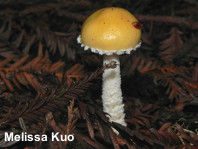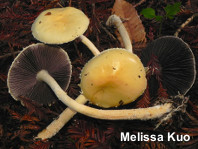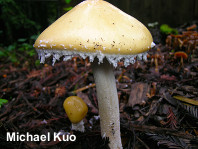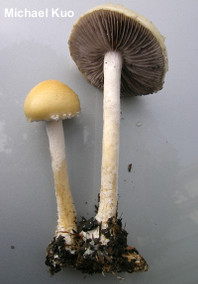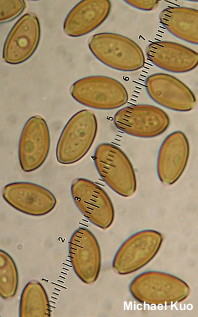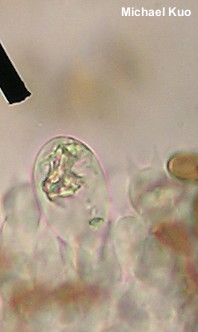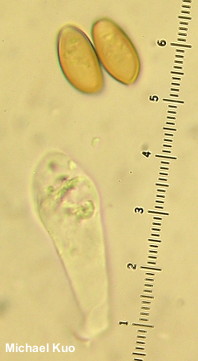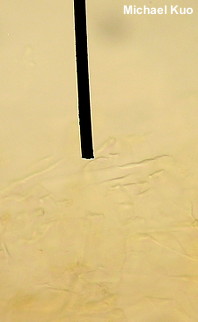| Major Groups > Gilled Mushrooms > Dark-Spored > Stropharioid Mushrooms > Stropharia ambigua |

|
Stropharia ambigua [ Basidiomycota > Agaricales > Strophariaceae > Stropharia. . . ] by Michael Kuo The folks on the West Coast are bored with Stropharia ambigua, but for a Midwesterner on a winter (!) mushroom vacation it's about the coolest thing going. It's huge, bright yellow, slimy, and adorned with drooping white partial veil remnants. What more could you ask for in a mushroom? So when my California friends tell me that Stropharia ambigua is a mushroom "weed" in coastal areas, I compare it with the thoroughly non-thrilling Stropharia hardii, which is the closest look-alike back east, and I wish that Hamlet had been right, and that the whole world could be "an unweeded mushroom garden, grown to seed." Yeah, I threw a word in there. Thanks to the Herbarium of the University of Michigan for facilitating my study of the Stropharia ambigua collection cited below. Description: Ecology: Saprobic; growing alone or gregariously on woody debris in conifer and (sometimes) hardwood forests, or in wood-chip beds; fall through spring; West Coast. The illustrated and described collections are from California and Alaska. Cap: 3–14 cm; hemispheric to convex at first, becoming broadly convex or nearly flat; slimy when fresh; yellow to brownish yellow or pale yellow; bald; the margin adorned with hanging white partial veil remnants, especially when young. Gills: Attached to the stem or beginning to pull away from it; close; whitish to very pale gray at first, becoming purplish gray to purple-black; with whitish edges when mature. Stem: 6–16 cm long; 1–2 cm thick; equal; dry; with a ring or ring zone that may disappear; bald above the ring and finely shaggy below it; basal mycelium white; base often with white mycelial threads. Flesh: White; unchanging when sliced. Odor: Not distinctive, or somewhat radishlike to mealy. Spore Print: Dark purple-brown to blackish. Chemical Reactions: KOH on cap surface pale orange. Microscopic Features: Spores 11–16 x 6–8 µm; ellipsoid; with a large pore at one end; smooth; thick-walled; brown in KOH. Basidia 4-sterigmate. Pleuro-chrysocystidia 30–50 x 10–15 µm; clavate, or clavate with a narrowed, angular apex; smooth; thin-walled; hyaline; inclusions small, globular, and golden-refractive. Cheilo-chrysocystidia not found. Lepto-cheilocystidia present; basidiole-like. Lamellar trama parallel. Pileipellis an ixocutis; elements poorly defined, hyaline to golden in KOH, 2.5–5 µm wide. REFERENCES: (Peck, 1898) Zeller, 1914. (Saccardo, 1902; Stamets, 1978; Smith, Smith & Weber, 1979; Arora, 1986; Phillips, 1991/2005; Lincoff, 1992; Trudell & Ammirati, 2009; Kuo & Methven, 2010; Desjardin, Wood & Stevens, 2015; Siegel & Schwarz, 2016.) Herb. Kuo 01130523, 01141101. Herb. MICH 53398. This site contains no information about the edibility or toxicity of mushrooms. |
© MushroomExpert.Com |
|
Cite this page as: Kuo, M. (2017, May). Stropharia ambigua. Retrieved from the MushroomExpert.Com Web site: http://www.mushroomexpert.com/stropharia_ambigua.html |
